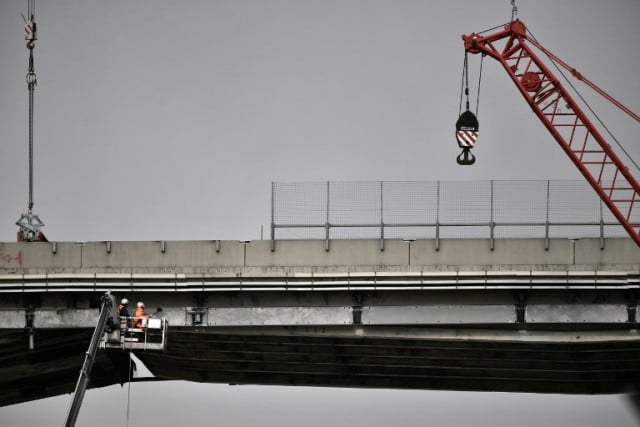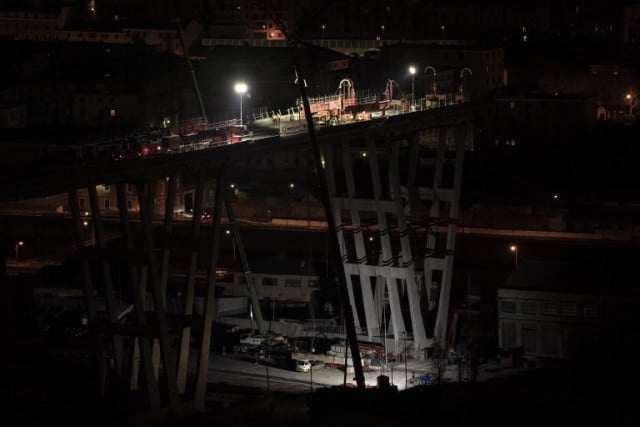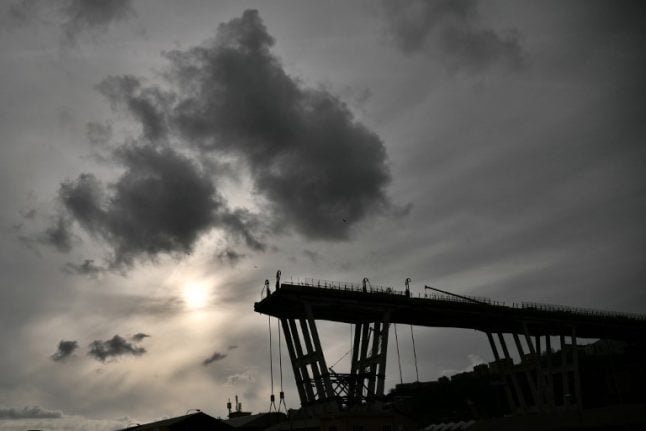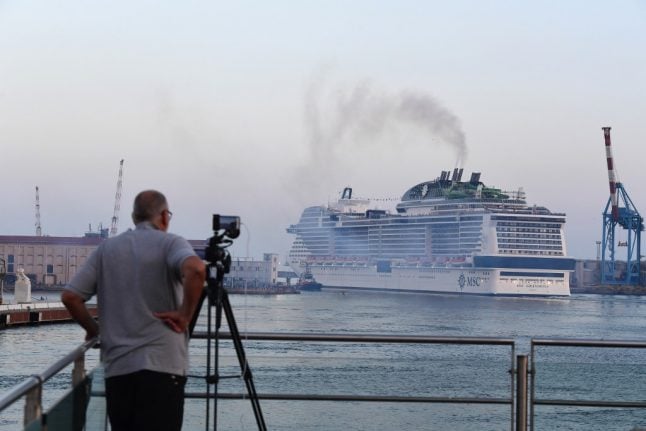Thousands of tonnes of steel, concrete and asphalt have already been removed from the spectacularly truncated high-rise bridge in the northern Italian port city to make it lighter before the “deconstruction” operation begins.
Four powerful strand-jacks positioned on the bridge by an enormous crane will unhook and slowly lower a 36 by 18 metre (118 by 59 foot) concrete slab weighing over 900 tonnes this morning.
The jacks are the same as those used to right the Costa Concordia cruise liner off Tuscany in 2013, after it ran aground and capsized with the loss of 32 lives.
The operation to lower the vast slab around 48 metres to the ground is expected to take eight hours, with Prime Minister Giuseppe Conte to attend the start.
Technicians set up material and work on the western section of the remains of the Morandi bridge on February 7. Photo: Marco Bertorello/AFP
It was initially hoped that the bridge could be demolished by the end of September. Investigators have been calling for the urgent demolition of the bridge's remains since August, warning that supports were weakening and at risk of collapse.
The symbolic operation will help the city move on from the August disaster, which beyond the human cost also ripped out one of the city's main transport arteries.
Italy's most famous living architect Renzo Piano, a Genoa native, has provided the design for the replacement bridge that “will last for 1,000 years”.
The new structure will look deliberately different from the old one, opened in 1967, and will feature 43 lamp poles in memory of those killed when a section collapsed during a storm on August 14, sending dozens of vehicles andtonnes of concrete tumbling to the ground.
The new bridge commission, headed by Genoa Mayor Marco Bucci, noted the new design “rests on pillars, respecting the feeling of psychological aversion in the city (to) other types of bridge with suspended or cable-stayed parts”.
It will “have elements of a boat because that is something from Genoa,” Piano has said, describing a streamlined and luminous white structure.
The new bridge is estimated to cost 202 million euros, making it one of the most expensive in Europe.
It is expected to be open to traffic by April 2020, junior transport minister Edoardo Rizi said on Thursday, with the demolition to take 190 days.
The old cable-stayed bridge was made from reinforced concrete, with the steel cables linking the bridge's towers also covered in concrete.

Technicians prepare to work on the remains of the Morandi bridge late on the night on February 7 Photo: Marco Bertorello/AFP
One theory investigators are looking into is that the steel within the concrete had dangerously decayed, although this would not have been visible.
There have also been allegations of poor maintenance, poor design and questionable building practices.
Explosives will be used to demolish the bridge from around February 20, Genoa's Repubblica newspaper reported.
The eastern side of the bridge, where the structure gave way, still needs to be examined by experts and prosectors.
Autostrade per l'Italia (Aspi) operated the failed bridge and several of its managers could face trial over the collapse.
Ahead of anticipated court proceedings, Aspi is still negotiating compensation payments with bereaved relatives, reportedly for a total of 50 million euros.
For the first time in an Italian public works contract, the construction companies face stiff penalties of up to 202,000 euros a day for any delays.
Civil engineering expert Pierre Corfdir said planning the demolition of a bridge this size (over 1,180 metres) would normally take around three years.
“This is one of the most complex bridge demolitions,” because of the built-up environment, said Corfdir, who works at France's Cerema institute.
“There's also time pressure: they have to rebuild a bridge that is of vital importance to the city's economy.”
READ ALSO:



 Please whitelist us to continue reading.
Please whitelist us to continue reading.
Member comments